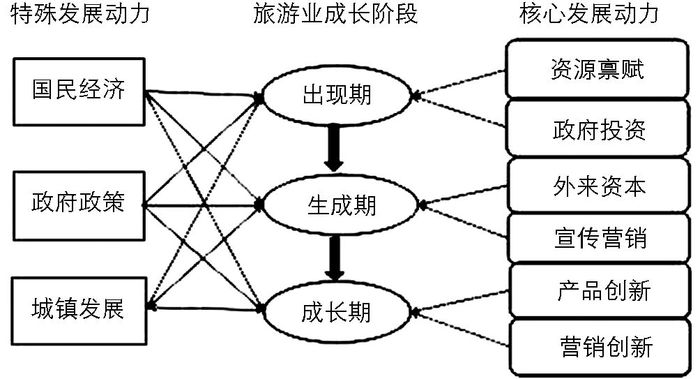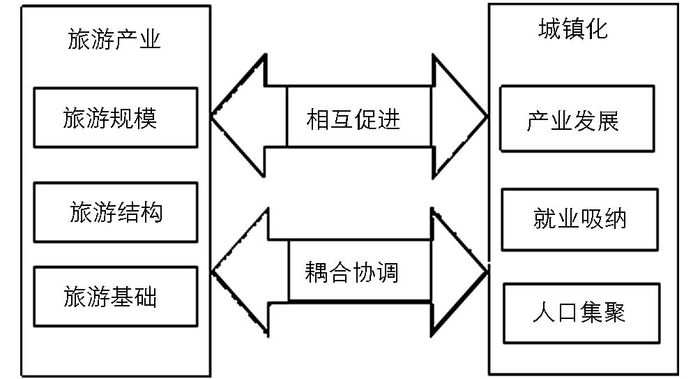-
城镇化是人类经济社会发展的客观要求和必然产物[1].旅游作为一种特殊经济活动,是推动旅游地城镇化发展的重要力量[2].在国外,Truly,Luchiari等指出旅游活动引起了旅游流的移动和劳动力向旅游地迁移,以旅游作为支柱产业的地区其城市化建设围绕旅游业发展进行,旅游产业发展促进了城市化发展[3-6].在国内,陆林等对旅游城镇化概念进行了界定[7],王兆峰、麻学锋等对张家界旅游业与城镇化之间的关系进行了研究[8-9],高楠、马耀峰等借鉴耦合理论定量研究了两者之间的互动关系[10].纵观国内外研究成果,学者对旅游产业与城镇化之间关系的研究正逐步深入,研究范围得到拓展.但已有成果多集中在对旅游城镇化概念界定、关系描述等方面,虽有旅游业与城镇化耦合研究成果,但还鲜见从产业生成视角分析旅游业与城镇化耦合发展的研究,尤其缺乏对城镇化发展的核心基础(产业发展、就业吸纳和人口集聚)进行系统分析.
张家界因旅游建市.在1989到2014这26年中,其旅游收入由0.25亿元增长到248.7亿元,占GDP比重由1.7 %增长到61%;同时城镇人口由18.99万人增长到65.8万人,城镇人口占总人口的比率由13.02%增长到43.32%.综上看来,在此期间张家界市的旅游业与城镇化水平都有很大提高.基于此,本文以张家界为例,结合旅游产业生成周期,运用熵值法、耦合度、耦合协调度,从产业生成新视角,以城镇化发展的核心为基础,探讨张家界旅游产业与城镇化耦合发展的动力及机制,在理论上为旅游业与城镇化耦合分析提供新视角,拓展研究深度,实践上为张家界旅游业与城镇化良性互动发展提供科学依据.
全文HTML
-
旅游产业生成是旅游产业在某区域出现、生成到发展的动态过程,具有地理上的空间性和时间上的延续性[11].借鉴文献[11]的研究将张家界旅游产业生成周期划分为出现期(1989-1998年)、生成期(1999-2007年)、发展期(2008年以来)来具体分析其旅游产业化与城镇化的演化.
-
旅游产业生成实质是多种力量共同作用的结果,每一阶段都有不同的核心动力推动产业成长.结合旅游地发展因子[12],本文构建了张家界旅游业发展核心动力分析框架(图 1).
1) 出现期:其核心动力为资源禀赋和政府投资.旅游业是打造中国经济升级版的新引擎[13],政府为利用好这一新引擎,会大量投资以期打造特色旅游景区,实现经济发展.
2) 生成期:核心动力为宣传营销和外来资本投资.旅游地相关配套设施基本建成,利益部门为扩大景区知名度,会实施一系列营销手段.随着景区知名度提高,大量外来资本涌入,与旅游相关的服务业骤增.
3) 发展期:核心动力为营销创新与旅游产品创新.面对市场需求的迅速变化,旅游地应利用资源优势及时优化旅游产品,开发与众不同的产品,以占据更大市场.在营销宣传上大力创新营销模式,走出去与请进来紧密结合,通过主办热点赛事、“制造事件”等方式,开拓客源市场,实现景区发展新飞跃.
由图 1可见,旅游业发展过程中,一直伴随着3个特殊动力:国民经济增长、政府政策制定和城镇发展.旅游是种经济活动,需建立在一定经济关系基础之上[14],只有在人民生活水平普遍提高的背景下,才能将更多潜在游客转化为实际游客,从而推动旅游业快速发展.政府的宏观调控政策对旅游地的成长速度、发展方向都起着重要的指导和服务作用,贯穿于旅游地成长的始终.城镇化与产业发展紧密相连[15],旅游产业能带动人口、资本和物质等生产力要素的积聚和扩散[16],城镇化对客源市场、旅游产品开发又具有显著的推动作用,两者存在明显的互动关系[17-18].
-
物理学中,耦合是指两个或两个以上系统或运动形式通过各种相互作用而彼此影响的现象[19].耦合度是描述系统或要素相互影响的程度,耦合协调度是度量系统或内部要素间在发展过程中彼此和谐一致的程度,体现了系统由无序走向有序的趋势[20].
-
产业发展的规模与布局推动土地城镇化发展,就业吸纳促进城镇优质人口数量的提升,人口集聚加速人口城镇化规模[20].故从产业发展、就业吸纳角度,来阐释旅游业与城镇化的关系是必要且有实际意义的. 2014年《中国新型城镇化》一书中也明确指出“推进城镇化必须统筹好产业发展、就业吸纳和人口集聚的关系”.因此,本文以产业发展、就业吸纳、人口集聚为基础,来探讨城镇化发展与旅游业成长的耦合关系.
首先,旅游业发展促进城镇化建设. ①现代旅游业已成为工业化城镇化深入发展的新引擎,不仅可以有效提升城市综合发展能力,而且可以撬动区域产业结构的升级换代[8].旅游产业综合性强[21],能带动酒店、餐饮等服务行业规模的扩张,促进整体服务水平提高、产业结构升级,从而在产业发展方面推动城镇化建设. ②旅游业发展推动旅游目的地人口和产业的集聚和扩散,从而带动城镇化发展[16, 22].以旅游为主导的服务业属于劳动密集型产业,旅游业的蓬勃发展促使产业集聚,使得城镇化就业吸纳能力增强,形成人口集聚于城镇的现象,从而推动人口城镇化.
其次,城镇化进程助推旅游业发展. ①研究发现,经济发展水平较低时,城市化与第二产业联系更为紧密;当经济发展达到较高水平时,则与第三产业关系更加紧密[23],即城镇化发展会促进服务业扩展[24],从而扩大第三产业在当地国民经济中的比重,增大旅游业规模,加速旅游结构升级. ②城镇化发展能有效增强城镇旅游业的发展基础和动力[14].城镇化进程的推进,使得对交通、基础服务、环境卫生等居住环境的要求普遍提高,从而推动城镇基础设施完善,服务体系优化,城市形象提高.旅游业成长与城镇化发展耦合协调机制如图 2所示.
1.1. 旅游产业生成内涵
1.2. 旅游业成长核心动力分析
1.3. 耦合机制分析
1.3.1. 耦合内涵
1.3.2. 耦合协调机制
-
根据旅游业成长与城镇化发展的内在本质,遵循数据可获得性、科学性等原则,本文共设计了2个系统层、6个要素层、16个指标层(表 1).
从规模、结构、基础3方面着手来反映旅游产业的发展.旅游收入代表旅游业产出规模,旅游人次、境外旅游人次分别从人口数量和质量上体现旅游业经营规模,从而展现旅游业经营景气程度,故选取这3个指标能真实客观反映旅游产业规模.选取旅游收入占GDP比重和旅游收入占第三产业比重,分别反映旅游收入对整个国民经济的贡献程度以及旅游收入在第三产业中的地位.产业基础是产业发展的保证,选取旅游投资、景点个数与旅行社数量和旅游饭店数量3个指标能客观反映其旅游基础.从产业发展、就业吸纳、人口集聚3方面综合衡量城镇化系统发展水平.产业发展的重要特征即为产业结构高级化[25],人均GDP代表地区整体经济状况,城镇居民人均可支配收入反映当地城镇居民的生活水平,因此产业结构高级化指数、人均GDP和城镇居民人均可支配收入能有效衡量当地产业发展情况.就业吸纳是城镇化发展的核心任务,从业人员数和第三产业从业人员数能分别从整体层面和重点层面反映区域就业情况,职工平均工资可以反映当地产业对职工需求情况,因此这三项指标能有效评价其就业吸纳能力.人口集聚是产业发展、就业吸纳的结果,本文选取城镇人口占总人口比重和城市人口密度两项指标,分别从数量层面和空间层面来测量城镇人口聚集程度.为更好反映旅游业对城镇化水平的效用,本文中的城镇人口为统计意义上的人口与旅游人口折算为城镇人口[26]之和.
-
熵值法是一种客观赋权法,能较好避免多指标变量间的信息重叠和人为权重的主观性,赋予的权重具有客观性和可信性[27].本文借鉴高楠、马耀峰等[28]计算方法,得出各个指标权重,为避免在计算过程中出现0而无法求对数的现象,在无量纲化处理后对其增加0.001的偏移量(表 1).
-
城镇化是由相互依赖的若干部分组成的有机整体,可视为一个系统,旅游业亦是如此,两者形成“城镇化—旅游业”系统[25].文章参考其他学者对耦合度及耦合协调度的研究,得出旅游业系统与城镇化系统之间的耦合度(C)及耦合协调度(D)模型:
其中:U1为旅游业系统的发展水平函数,U2为城镇化系统的发展水平函数;T是旅游业与城镇化建设发展的综合水平;α和β为待定系数.鉴于张家界因旅游立市,且多数研究表明旅游业会加速城镇化发展,而城镇化则是由多方面因素综合促进的,因此本文将α设为0.6,β设为0.4且该设计通过25位专家的问卷反馈结果得到支持.将耦合协调度(D)划分为10种等级[26]:极度失调(0~0.09)、严重失调(0.1~0.19)、中度失调(0.2~0.29)、轻度失调(0.3~0.39)、濒临失调(0.4~0.49)、勉强协调(0.5~0.59)、初级协调(0.6~0.69)、中级协调(0.7~0.79)、良好协调(0.8~0.89)、优质协调(0.9~1).
-
研究期为1989-2014年,数据主要来源于《张家界统计公报》、《张家界统计年鉴》以及CNKI等网络工具.对于无法直接取得的数据,在借鉴已有数据的基础上采用均值插补法进行赋值.
2.1. 旅游业成长和城镇化发展指标体系构建
2.2. 研究方法
2.2.1. 熵值法
2.2.2. 旅游业与城镇建设耦合协调模型
2.3.3. 数据来源
-
本文选取旅游收入占GDP比重和城镇人口占总人口比重两个指标对张家界旅游业成长与城镇化的关系进行分析.由图 3可见,旅游业一方面呈现快速成长态势,另一方面呈现脆弱性特点,从2003年(SARS)和2008年(世界金融危机)两个低点可见一斑.城镇化发展则呈稳定上升趋势.其原因是城镇和重大基础设施布局一旦确定,就很难再改变[29].
出现期(1989-1998年):自然的原生态环境尚未被打破,旅游景点数量少(3个)且服务设施简单,旅游投资有限(在1989年仅为816万元),餐饮等服务行业都处于筹建阶段,规模较小,旅行社、旅游饭店数量分别只有5家、39家且服务质量不高.这些现状决定了就业吸纳能力较差,全市第三产业从业人员在1989年仅为76339人.该阶段旅游人数较少,1989年旅游总人次为56.49万人,旅游收入占GDP、第三产业比重分别只有1.7%,3.44%.旅游业发展主要动力为政府投资.城镇化过程中,一、二、三产业的比例在1989年为47:18.97:34.3,产业高级化指数均值为2.12,说明该阶段经济发展主要依赖于一、二产业.人均GDP为1006元,城镇化水平(13.02%)较低,人口集聚程度不高.此时的城镇化水平虽然较低,但发展程度要大于旅游业.
生成期(1999-2007年):旅行社和旅游饭店的规模、质量都有了质的飞越,其数量较1989年分别增长了2.55倍和1.76倍,旅游景点由最初的3个上升到2007年的10个.旅游业发展致力于加大对旅游景区开发的深度和对旅游景点宣传的广度.如1999年“飞机穿越天门”的成功营销,使得张家界声名大噪,大量游客慕名而来,尤其是外国游客,由1998年的3.04万人次增长到1999年的15.15万人次.旅游人数的增多带动服务部门激增,就业吸纳能力增强,2007年,全市第三产业从业人员较出现期增长了近3.1倍,促使人口集聚于城市,带动城镇人口增加到75.83万人.旅游资本较1999年增长了约3.5倍,不仅带动了周边地区服务设施的健全,还推动了第二产业发展,其产业增加值在2007年达到35.97亿元,赶超第一产业增加值.该阶段城镇居民可支配收入和职工平均工资的增长率分别高达102.22%,207.37%.旅游业和城镇化均呈现快速增长势态,且旅游业成长要高于城镇化发展.此阶段产业高级化指数均值上升到2.38,在2007年,一、二、三产业比例为16.78:23.79:59.43,作为第三产业核心的旅游业(旅游收入占第三产业比重为97.56%)对推动城镇化发展起到关键作用.
发展期(2008年以来):旅游成为时尚,旅游人次大幅增加,旅游收入占GDP的比重和第三产业的比重在2014年分别达到60.66%,95.29%,旅游业的经济主导地位更加稳固. 2014年,旅游投资为1.4亿元,景点数量达14个,旅行社和旅游饭店数量分别是67家、919家,第三产业从业人员是发展期的1.37倍,就业吸纳能力进一步增强.此时,旅游地各服务业间及不同旅游地间客源市场竞争激烈,迫使旅游业在不断探寻新旅游产品的同时,大力创新营销手段,以保持旅游竞争力和吸引力.该时期的城镇化水平更进一步,人均GDP和城镇居民收入较2008年分别增长了2.26倍和1.71倍,产业结构比例为12.03:24.34:63.65,产业高级化指数均值为2.49,人口集聚程度进一步提高,城镇化率已由46.92%增长为58.76%.城镇化与旅游业发展相互交织,差异不大,呈现相互带动、协调发展的大好局面.
-
城镇化的有序推进有利于促进旅游业的迅速发展,反之,旅游业又促进了城镇化进步. 1989-2014年张家界旅游系统和城镇建设系统的耦合协调情况如图 4所示.
出现期(1989-1998年):为解决大庸、慈利、桑植三地因旅游业发展而引发的矛盾,1988年国务院重新划分行政区域,将大庸市升级为地级市,自此张家界旅游业发展开始步入正轨.由图 4可见,U1和U2都呈上升趋势,U1低于U2,但U1的斜率要远大于U2,并随着时间的推移逐渐向U2靠近.究其原因,整个旅游业因受之前行政区划影响,诸如边界共有资源争夺等问题,使其发展受到一定限制,不能很好发挥资源禀赋的优势. 1994年大庸市更名为张家界市,自此之后,U1与U2分别由0.056 0,0.156 1增长到1998年的0.127 2,0.257 8,U1增长速度远超U2.耦合度呈波动趋势,由1989年的0.216 5波动上升到1998年的0.470 4,两系统相互作用、相互影响的程度相对不稳定.耦合协调度呈平稳上升趋势,由1989年的极度失调(0.048 6)转变到1998年中度失调(0.290 5),两系统的关系总体在改善,但耦合等级很低,发展矛盾依然明显.
生成期(1999-2007年):U1和U2分别由1999年的0.168 9,0.291 1增长到2007年的0.572 8,0.595 9,U1增速依然很快并有赶超U2的趋势.原因包括:该时期相关旅游配套设施趋于成熟,加上宣传力度增大,促使旅游地声名远播;国民经济水平提高,更多潜在游客转化为实际游客;市委市政府围绕“着力打造世界旅游精品”的目标,积极开展各项工作,加速产业转型升级.旅游业的蓬勃发展相应带动了城镇化建设的进步,促使产业集聚,资本增加、就业岗位增多,就业吸纳能力增强,经济水平提高.耦合度围绕0.50上下浮动,两者相互作用强度相对稳定.耦合等级由1999年的轻度失调(0.324 0)转变为2007年的勉强协调(0.539 4),表明两大系统的发展势头良好,向着相互扶持、相互促进、相互协调的新阶段迈进.
发展期(2008年以来):2008年以来,有关部门相继出台了多项文件,以扶持旅游产业的发展.受2008年世界金融风暴影响,旅游收入由91.25亿降到了83.49亿元,减少了7.76亿元.为应对此次冲击,政府和旅游行业积极推出“张家界山歌节”等带有民族风味的旅游新产品,激发旅游需求的同时,也弘扬了民俗文化.此外,响应市委市政府“1656行动计划”,一大批景区实施了提质改造,碧桂园凤凰酒店等高端休闲酒店的正式营业,提高旅游承载能力的同时,也改变了张家界只停留在观光阶段的局面;旅游营销推陈出新,世界翼装飞行表演等重大促销活动的举办,使张家界世界旅游城市的形象进一步深入人心,有力拉动了经济增长. U1和U2依然呈上升趋势,在2014年其值分别达到0.989 1,1.001.耦合度依然围绕0.5上下浮动,且振幅不超过0.01;耦合等级由2008年的勉强协调(0.527 0)上升到2014年的中级协调(0.704 9),两系统发展的矛盾趋于缓和,协调程度进一步加强,然而相对于各自综合发展水平较高的局面,两者的协调程度仍有很大上升空间.
3.1. 张家界旅游业成长与城镇化关系演变特征分析
3.2. 基于旅游产业生成周期的两系统耦合分析
-
本文选取张家界市旅游系统和城镇化系统共16个指标,运用熵值法及耦合模型,从产业生成视角系统分析了各阶段推动两大系统发展的主要动力与成因及两系统耦合发展情况,结果发现:①张家界旅游系统与城镇化系统自1989年以来,两者各自的发展水平都有很大提高.期间,旅游发展与外界大环境息息相关,随环境的变化呈波动上升趋势.城镇化发展则相对平稳,呈稳定上升趋势. ②旅游产业生成周期的各阶段,因经济发展状况、旅游资源开发情况、外界大环境和政府政策导向的不同,其核心动力会有差异,两大系统的关系也在发生变化.出现期的核心动力是资源禀赋和政府投资,城镇化推动旅游业发展;生成期的核心动力是外来资本和宣传营销,旅游业带动城镇化加速发展;在发展期,开发旅游新产品和创新营销模式成为旅游业发展新动力,旅游业成长与城镇化发展逐渐呈相互促进、相互协调的发展趋势. ③从耦合度及耦合协调度来看,张家界耦合度由1989年的0.216 5波动增长到2000年的0.496 4,自此围绕0.49上下浮动,且振幅都极小,不足0.01,耦合协调度由出现期的极度失调(0.048 6)到生成期的轻度失调(0.324 0)到发展期的勉强协调(0.527 0)再到2014年的中级协调(0.704 9),虽然期间有些波动,但整体耦合协调度呈上升趋势.
-
文章虽对指标权重的计算采用了客观赋值法-熵值法,避免了人为因素带来的偏差,但因每人看待问题的不同,选取的指标也不尽相同,继而得到的结论会出现差异.以张家界为例,深入探讨了旅游产业成长与城镇化之间的关系,并得出各阶段旅游产业成长的核心动力,其是否具有普适性,值得再考虑和更多实证支持.本文仅局限于对张家界整体旅游业成长周期与城镇化耦合关系的研究,忽略了其在空间上的差异性,这也是今后需要深入研究的方向.




 下载:
下载:


